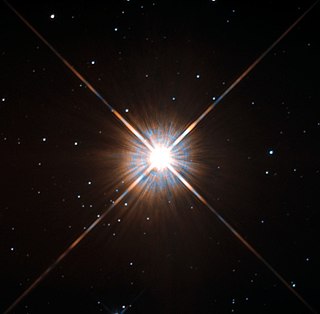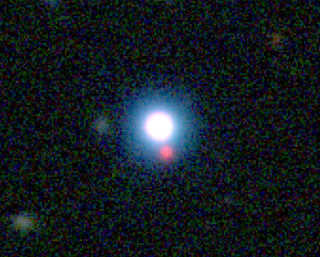
In astronomy, the main sequence is a continuous and distinctive band of stars that appears on plots of stellar color versus brightness. These color-magnitude plots are known as Hertzsprung–Russell diagrams after their co-developers, Ejnar Hertzsprung and Henry Norris Russell. Stars on this band are known as main-sequence stars or dwarf stars. These are the most numerous true stars in the universe, and include the Earth's Sun.

A star is an astronomical object consisting of a luminous spheroid of plasma held together by its own gravity. The nearest star to Earth is the Sun. Many other stars are visible to the naked eye at night, but due to their immense distance from Earth they appear as fixed points of light in the sky. The most prominent stars are grouped into constellations and asterisms, and many of the brightest stars have proper names. Astronomers have assembled star catalogues that identify the known stars and provide standardized stellar designations. The observable universe contains an estimated 1022 to 1024 stars, but most are invisible to the naked eye from Earth, including all individual stars outside our galaxy, the Milky Way.

In astronomy, stellar classification is the classification of stars based on their spectral characteristics. Electromagnetic radiation from the star is analyzed by splitting it with a prism or diffraction grating into a spectrum exhibiting the rainbow of colors interspersed with spectral lines. Each line indicates a particular chemical element or molecule, with the line strength indicating the abundance of that element. The strengths of the different spectral lines vary mainly due to the temperature of the photosphere, although in some cases there are true abundance differences. The spectral class of a star is a short code primarily summarizing the ionization state, giving an objective measure of the photosphere's temperature.

Brown dwarfs are substellar objects which are not massive enough to sustain nuclear fusion of ordinary hydrogen (1H) into helium in their cores, unlike main sequence stars. They have a mass between the most massive gas giant planets and the least massive stars, approximately 13 to 80 times that of Jupiter (MJ). However, they are able to fuse deuterium (2H), and the most massive are able to fuse lithium (7Li).

A red dwarf is the smallest and coolest kind of star on the main sequence. Red dwarfs are by far the most common type of star in the Milky Way, at least in the neighborhood of the Sun, but because of their low luminosity, individual red dwarfs cannot be easily observed. From Earth, not one star that fits the stricter definitions of a red dwarf is visible to the naked eye. Proxima Centauri, the nearest star to the Sun, is a red dwarf, as are fifty of the sixty nearest stars. According to some estimates, red dwarfs make up three-quarters of the stars in the Milky Way.

A black dwarf is a theoretical stellar remnant, specifically a white dwarf that has cooled sufficiently that it no longer emits significant heat or light. Because the time required for a white dwarf to reach this state is calculated to be longer than the current age of the universe, no black dwarfs are expected to exist in the universe as of now, and the temperature of the coolest white dwarfs is one observational limit on the age of the universe.

During 1944, Walter Baade categorized groups of stars within the Milky Way into stellar populations.

A rogue planet is a planetary-mass object that does not orbit a star. Such objects have been ejected from the planetary system in which they formed or have never been gravitationally bound to any star or brown dwarf. The Milky Way alone may have billions to trillions of rogue planets, a range which the upcoming Nancy Grace Roman Space Telescope will likely be able to narrow down.

In astronomy, metallicity is the abundance of elements present in an object that are heavier than hydrogen and helium. Most of the normal physical matter in the Universe is either hydrogen or helium, and astronomers use the word "metals" as a convenient short term for "all elements except hydrogen and helium". This word-use is distinct from the conventional chemical or physical definition of a metal as an electrically conducting solid. Stars and nebulae with relatively high abundances of heavier elements are called "metal-rich" in astrophysical terms, even though many of those elements are non-metals in chemistry.

Gliese 876 is a red dwarf approximately 15 light-years away from Earth in the constellation of Aquarius. It is one of the closest known stars to the Sun confirmed to possess a planetary system with more than two planets, after Gliese 1061, YZ Ceti, Tau Ceti, and Luyten's Star; as of 2018, four extrasolar planets have been found to orbit the star. The planetary system is also notable for the orbital properties of its planets. It is the only known system of orbital companions to exhibit a near-triple conjunction in the rare phenomenon of Laplace resonance. It is also the first extrasolar system around a normal star with measured coplanarity. While planets b and c are located in the system's habitable zone, they are giant planets believed to be analogous to Jupiter.
Fred C. Adams is an American astrophysicist who has made contributions to the study of physical cosmology.

Mu Cassiopeiae, Latinized from μ Cassiopeiae, is a binary star system in the constellation Cassiopeia. This system shares the name Marfak with Theta Cassiopeiae, and the name was from Al Marfik or Al Mirfaq (المرفق), meaning "the elbow". It is dimly visible to the naked eye as a point of light with an apparent visual magnitude of 5.16. The system is located at a distance of 24.6 light years from the Sun based on parallax, and is moving closer with a high radial velocity of −98 km/s. This star will move into the constellation Perseus around 5200 AD.

Most observations suggest that the expansion of the universe will continue forever. If so, then a popular theory is that the universe will cool as it expands, eventually becoming too cold to sustain life. For this reason, this future scenario once popularly called "Heat Death" is now known as the "Big Chill" or "Big Freeze".
HD 131664 is an 8th magnitude star in the southern constellation of Apus with an orbiting brown dwarf companion. Parallax measurements by the Gaia space observatory provide an estimated distance of 172.5 light years from the Earth. The system is moving further away with a baseline heliocentric radial velocity of +35 km/s.

A Pea galaxy, also referred to as a Pea or Green Pea, might be a type of luminous blue compact galaxy that is undergoing very high rates of star formation. Pea galaxies are so-named because of their small size and greenish appearance in the images taken by the Sloan Digital Sky Survey (SDSS).

J. Davy Kirkpatrick is an American astronomer at the Infrared Processing and Analysis Center at the California Institute of Technology in Pasadena, California. Kirkpatrick's research was named one of the top ten science accomplishments of the first ten years (1992–2002) of the W. M. Keck Observatory and one of the Top 100 Stories of 2011 by Discover Magazine.
Kelu-1 is a system of two brown dwarfs of spectral types L2 and L4 located in constellation Hydra at approximately 61 light-years from Earth. It is among the first free-floating later-than-M-type brown dwarfs discovered, and sometimes considered as prototype of L-type brown dwarfs.

GD 165 is a system of a white dwarf and a brown dwarf of spectral types DA4 + L4, located in constellation Boötes at approximately 103 light-years from Earth. GD 165 B remained the only brown dwarf companion of a white dwarf until the discovery of GD 1400 B, which was discovered 17 years later.
Gliese 686 is a star in the constellation of Hercules, with an apparent magnitude +9.577. Although it is close to the Solar System - at 26.5 light years - it is not the closest known star in its constellation, since Gliese 661 is 20.9 light years away. The closest system to this star is the bright μ Herculis, at 4.5 light years. They are followed by GJ 1230 and Gliese 673, at 7.2 and 7.6 light years respectively.














